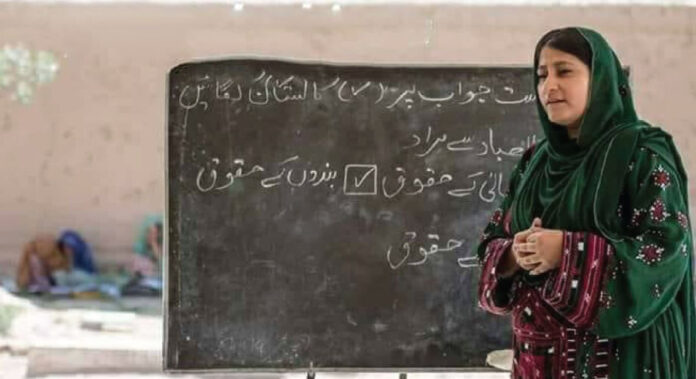It is tragically true that some women in the world are left beyond education and are totally caged. But scientifically, women have a better mental ability to understand the taught things in institutions than men. But they have been ignored in one way or another in the whole world. Because gender discrimination is very common in this part of the world; men can wander anywhere while females are trapped; men can freely get education, but women have to fight with their families and convince them; men are asked for women’s decisions; etc.
Pakistan is a federation of four provinces, among them one is Balochistan, the richest province by natural resources, but it is hit dismally with 75 percent of children as out of school and women’s education does not get attention because all are, to a great extent, struggling for their fundamental rights. According to the report of UNICEF Pakistan, only 27 percent of Balochistan’s women go to schools. Women’s education in Balochistan is the worst in the whole world.
One wonders whether we are living in a country where laws have no validity. To prove their competence, the current government of Balochistan needs to step forward to curb the educational woes of women in Balochistan. It becomes an ultimate test as to how the government deals with women’s education in the region
Disappointingly, most families in Balochistan are suffering from severe poverty. After working very hard, they rarely get food two times a day. In such circumstances, it becomes hard for families to hire transportation to send their children to schools and no educational institutions within the areas becomes the cause of making children drop out.
Further investigating about this bitter issue, I got to know about a village namely Khairabad where women’s education declines because of no institutions and poverty.
Khairabad, a very far-flung area, situated in the eastern part of Balochistan, has been deprived of education due to deterioration of educational and fundamental needs for females in particular. Khairabad has a very vast population of females. Unfortunately, a very small number of females are enrolled in educational situations while the majority of them had not been entertained to get education.
Sammi, a very desirous student resided in Khairabad, was very curious to continue her education after matriculation and was prepared to fulfil her future’s goals but all dreams went in vain when her parents did not afford to send her out of city so that she could continue her education. Hence, she gave up, being one of the victims.
Apart from lack of institutions within the area and poverty, another main reason which makes the girls drop out from education is early marriage. In Balochistan, six percent of girls aged 15 and 23 percent of women aged 20 are married, a ruining practice for hundreds of girls. According to a report, Makran has the highest number of early marriagea with 23 percent and Nasirabad carries 22 percent of early marriages making it second highest on the list. This calamity is yet to be prevented in the province which destroyed the educational life of Iqra, one of the victims of early marriage.
Iqra, a very hardworking and dedicated student to her study, was forcibly married by her parents. The early marriage ruined her dreams of getting higher education. Iqra is not the only unheard story, there are thousands of unheard stories who were forcefully married off in Balochistan.
Furthermore, long distance leads far from education. Rural areas of Balochistan are also facing similar problems. In most villages, a large number of women are not attending classes due to lack of schools for women. However, one can find schools but at long distances which make it tough for the women to attend them on a regular basis. According to Alif Ailaan’s report (2017), a primary school almost appears after every 30 km in Balochistan; a middle school after every 260 km and a high school after every 369 km.
Hoshab, a sub-Tehsil of District Kech, falls in eastern Makran, experiences the issue of long distances. In Hoshab, girls must cover the distance of 17 km to reach the school and continue their education. Residents lodged so many grumbles and grievances. To add more, no transportation in rural areas makes it tough for girls to cover a long distance to attend the classes regularly and it is also unsafe for girls to go by foot.
Additionally, in Dera Bugti and Panjgur districts of Balochistan, women are kept out of schools by religious extremists who completely forbid educating women. Institutions with co-education were even targeted and threatened to be closed completely and permanently. Even though a school van was burnt on its way to school, and then the extremists attacked the given school. After this incident, the school remained closed for a couple of years which resulted in the elimination of a teacher who was promoting women’s education in these regions and was even a little successful. When he was killed, his striving for promoting women’s education ended, and it returned to its old spot. Extremists do not allow women to get education, and the reason behind it is not distinguished yet.
One wonders whether we are living in a country where laws have no validity. To prove their competence, the current government of Balochistan needs to step forward to curb the educational woes of women in Balochistan. It becomes an ultimate test as to how the government in rule deals with women’s education in the region.























